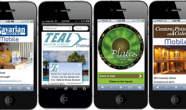What It Means to Be Responsive
Responsive Web design means using technology to detect screen size and adjust on-screen content so that it best fits the viewers needs. Responsive Web design uses principles such as fluid grids. Typically, you control this fluidity through CSS and flexible labels like percentages rather than pixels or ems. When you extend fluidity to images, you’re also able to prevent your layout from “breaking” when someone uses a smaller screen or resizes his browser.
One thing to take into consideration when creating a brand-new responsive design or adding responsiveness to your existing layout is whether all your elements are necessary on a smaller screen. Do they help the visitor who is browsing on her tablet? If those elements aren’t necessary, you can remove them simply by setting the display property of that CSS element to “none.” This is especially useful if your site contains ads or extra images that increase loading time.
Who Needs a Responsive Site Anyway?
In the digital era, people might be browsing on their PCs, but they might also be using their iPhones or Kindle Fires to check out your website. Responsive Web design comes as a response to frustration small businesses and designers experience due to the increase in the number of devices with different resolutions. When your website is responsive, you don’t need multiple versions, nor do you need to send visitors to “mobile.yoursite.com.” It just works on every device, and that allows you to breathe a sigh of relief.
Responsive design also tackles the issue of screen orientation. You never known when the visitor is going to flip her phone or tablet while viewing your site. Doing this provides additional real estate, which you can use to provide more content or increase readability, and your visitors will definitely appreciate that thoughtfulness.
65% of consumers research purchases before heading to the store, and if your customers are doing so while transporting to your store and your website isn’t responsive, you’re missing out on an opportunity to inform the shopper. In fact, many people might be bypassing your physical location altogether if your website allows them to shop online. According to a study by comScore, 4 out of 5 consumers uses his mobile phone to shop online. Another study suggests that 25% buyers only make online purchases from their mobile devices.
Thus, the answer to who needs responsive design is “Everyone, including you!”
How can THP Creative help?
You can depend on THP to lead you through this digital age. Our experience includes responsive website design that will help your business to accommodate all visitors, no matter their screen size. Our goal for you includes creating a website that converts and we have the necessary skills and expertise needed to drive more traffic, convert more sales and increase your ROI. Call us today to see how we can help you further: 770-483-5973

